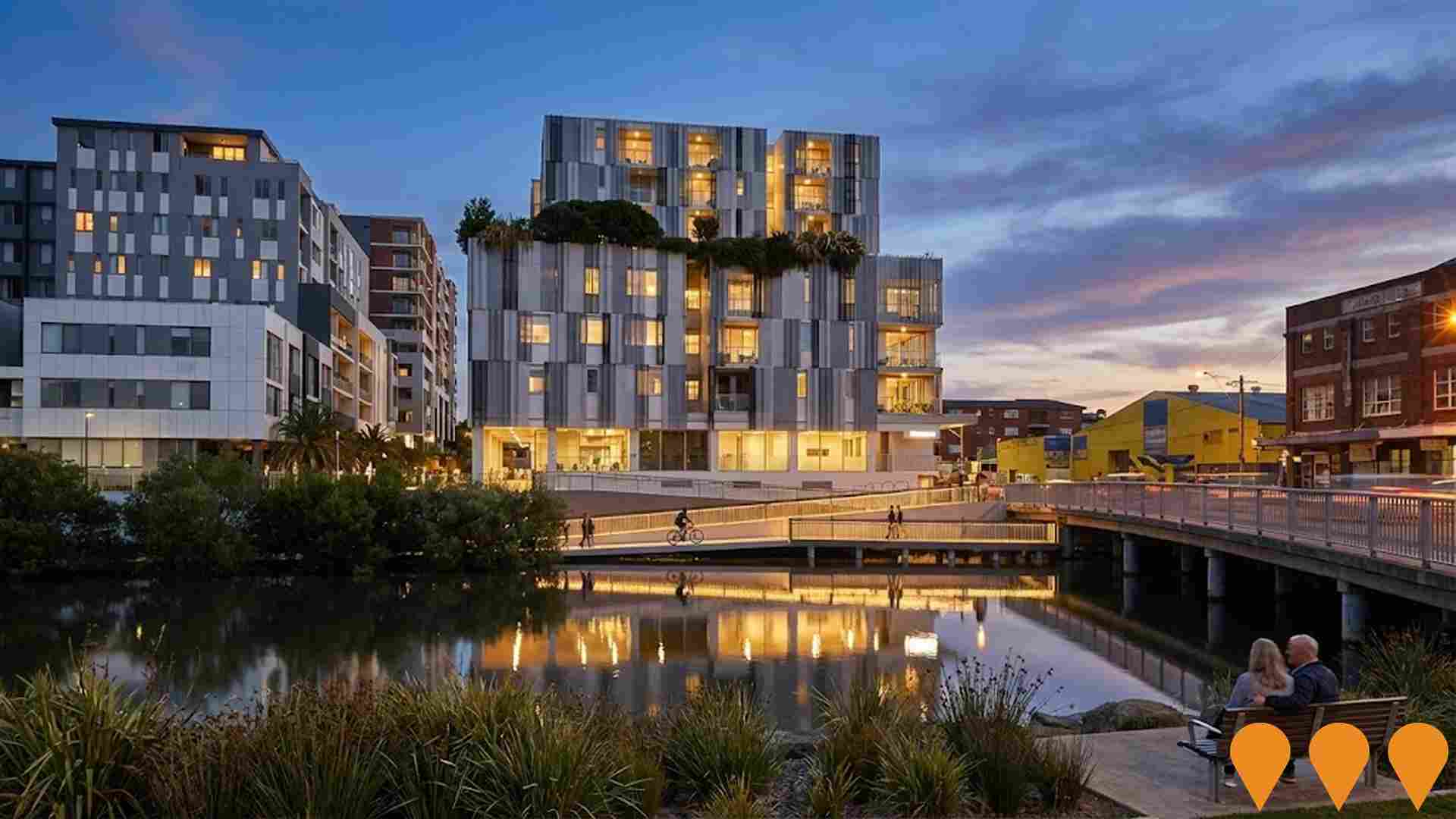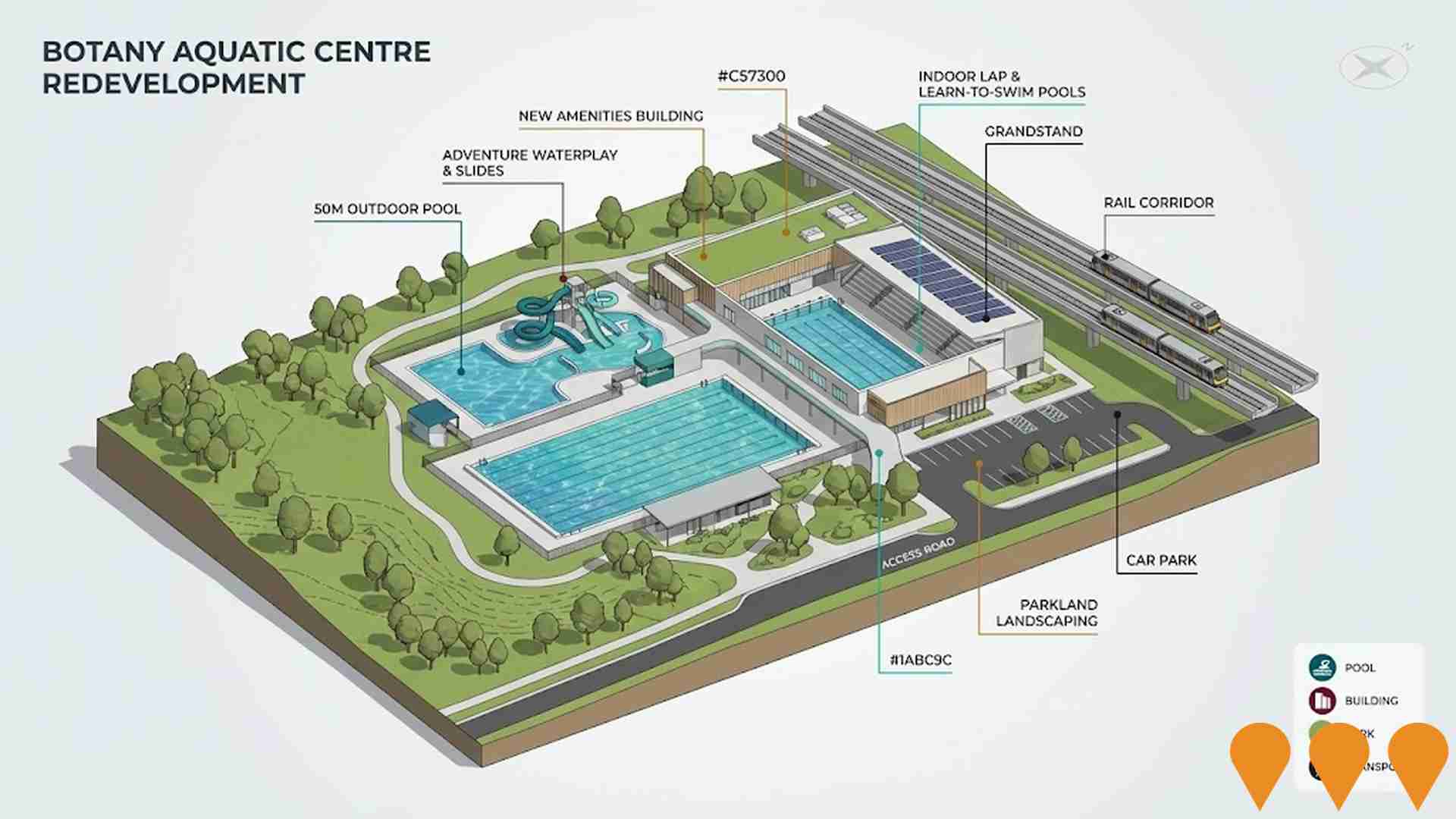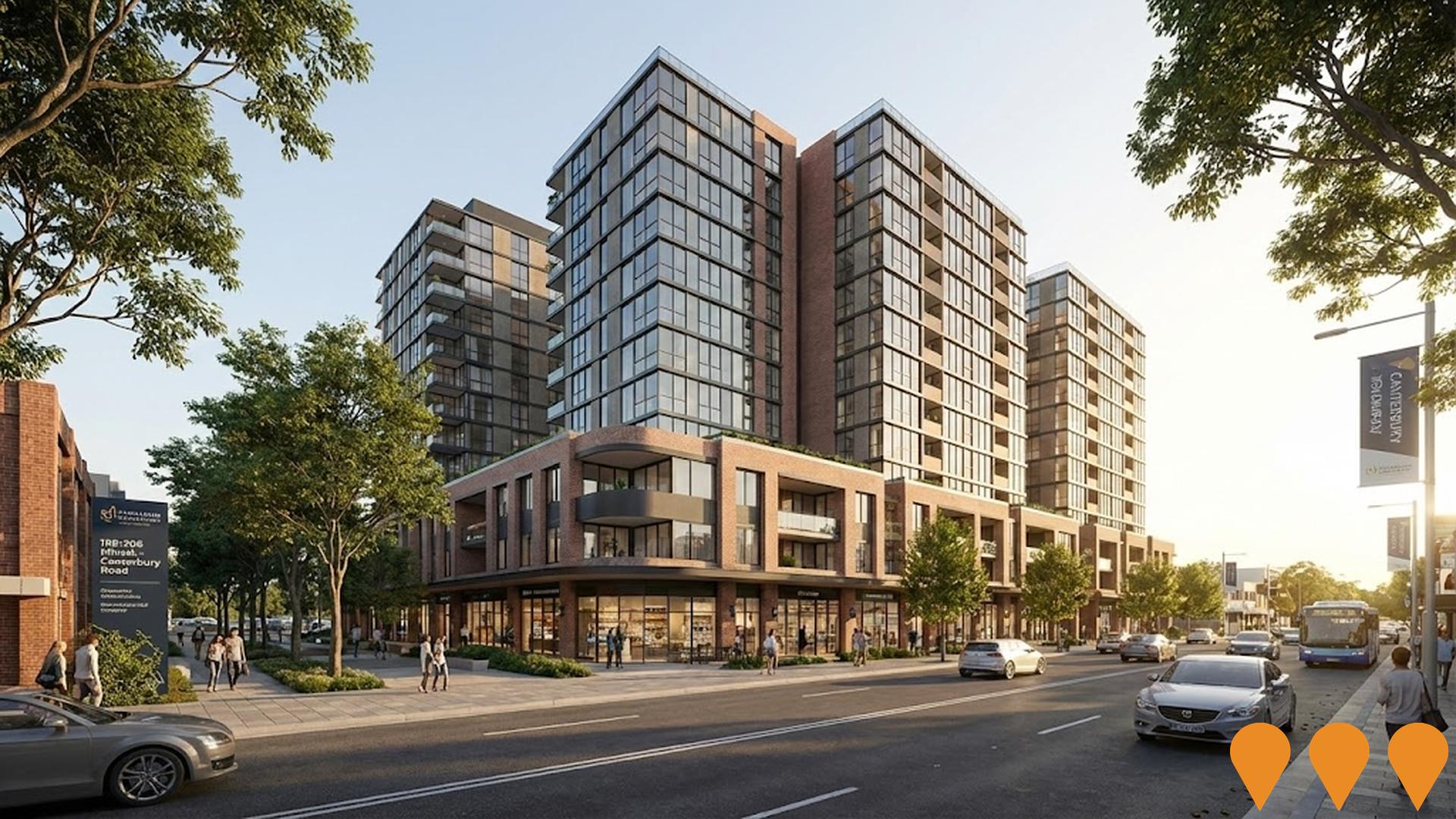Chart Color Schemes
est. as @ -- *
ABS ERP | -- people | --
2021 Census | -- people
Sales Activity
Curious about local property values? Filter the chart to assess the volume and appreciation (including resales) trends and regional comparisons, or scroll to the map below view this information at an individual property level.
Find a Recent Sale
Sales Detail
Population
Canterbury - South lies within the top quartile of areas nationally for population growth performance according to AreaSearch analysis of recent, and medium to long-term trends
Canterbury - South's population is approximately 13,182 as of August 2025. This figure represents an increase of 962 people, a rise of 7.9% since the 2021 Census which recorded a population of 12,220. The change is inferred from the estimated resident population of 13,175 in June 2024 and an additional 137 validated new addresses since the Census date. This results in a population density ratio of 6,307 persons per square kilometer, placing Canterbury - South in the top 10% of national locations assessed by AreaSearch, indicating high demand for land in the area. Canterbury - South's growth rate of 7.9% since the 2021 Census exceeds that of the SA3 area (4.6%) and the SA4 region, positioning it as a growth leader. Overseas migration contributed approximately 77.7% of overall population gains during recent periods in the area.
AreaSearch uses ABS/Geoscience Australia projections for each SA2 area, released in 2024 with a base year of 2022. For areas not covered by this data, AreaSearch employs NSW State Government's SA2 level projections, released in 2022 with a base year of 2021. Growth rates by age group from these aggregations are applied to all areas for the years 2032 to 2041. Future population trends indicate an above median growth for national areas, projecting Canterbury - South's population to increase by 2,531 persons to 2041 based on the latest numbers, reflecting a total increase of 19.1% over the 17 years.
Frequently Asked Questions - Population
Development
Residential development activity is slightly higher than average within Canterbury - South when compared nationally
Canterbury - South has seen approximately 44 dwelling approvals annually over the past five financial years, totalling 221 homes. As of FY-26, 18 approvals have been recorded. On average, each home built between FY-21 and FY-25 accommodates around 7.9 new residents per year, indicating demand outstripping supply. New homes are constructed at an average cost of $451,000, in line with broader regional development trends.
This financial year has seen $733,000 in commercial approvals, suggesting limited commercial development activity. Compared to Greater Sydney, Canterbury - South has shown slightly higher development levels over the past five years, with 33.0% more approvals per person. This maintains good buyer choice and supports existing property values, although recent periods have seen a moderation in development activity. New building activity consists of 24.0% detached houses and 76.0% townhouses or apartments, reflecting a shift towards compact living to provide affordable entry pathways for downsizers, investors, and first-time purchasers. With around 933 people per approval, Canterbury - South demonstrates its status as an established area with a mature population.
By 2041, the region is projected to grow by approximately 2,524 residents. If current construction levels persist, housing supply may lag behind population growth, potentially intensifying buyer competition and supporting price growth.
Frequently Asked Questions - Development
Infrastructure
Canterbury - South has very high levels of nearby infrastructure activity, ranking in the top 20% nationally
AreaSearch has identified a total of 51 infrastructure projects that could impact the area. Key projects include Sydney Metro City & Southwest, Campsie Private Hospital, Canterbury Leisure & Aquatic Centre, and the mixed-use development at 186-206 Canterbury Road. The following list details those projects most likely to be relevant.
Professional plan users can use the search below to filter and access additional projects.
INFRASTRUCTURE SEARCH
 Denotes AI-based impression for illustrative purposes only, not to be taken as definitive under any circumstances. Please follow links and conduct other investigations from the project's source for actual imagery. Developers and project owners wishing us to use original imagery please Contact Us and we will do so.
Denotes AI-based impression for illustrative purposes only, not to be taken as definitive under any circumstances. Please follow links and conduct other investigations from the project's source for actual imagery. Developers and project owners wishing us to use original imagery please Contact Us and we will do so.
Frequently Asked Questions - Infrastructure
Sydney Metro City & Southwest
30km metro rail extension from Chatswood to Bankstown via the Sydney CBD, including 15.5km of new twin tunnels under Sydney Harbour and the CBD and the upgrade of the existing T3 Bankstown Line to metro standards. The Chatswood to Sydenham section (including new stations at Crows Nest, Victoria Cross, Barangaroo, Martin Place, Pitt Street, Waterloo and upgrade of Central) opened on 19 August 2024. The final Sydenham to Bankstown section is now under construction and scheduled to open in 2026 following resolution of industrial disputes. Features driverless trains, platform screen doors and full accessibility. Total project cost approximately A$21.6 billion (2024 figures).
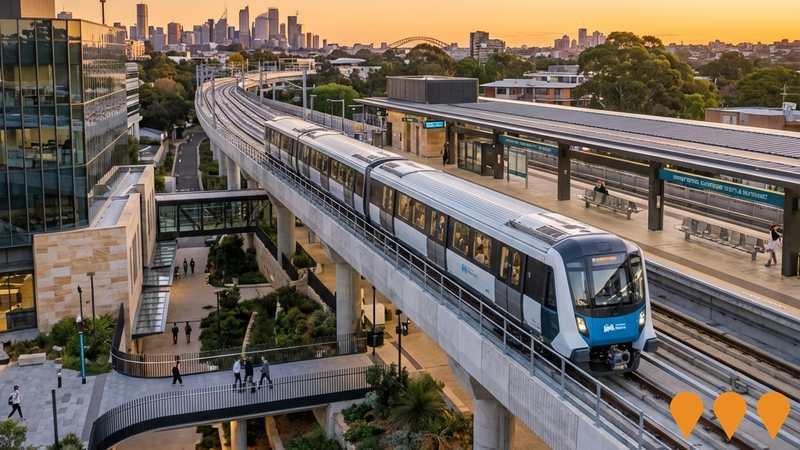
Campsie Private Hospital
A $450 million private hospital development by Neetan Investments on a 3.5 ha site in Campsie. The project will deliver a new 200-bed private hospital, 100-room medi-hotel, 150-place childcare centre, specialist consulting suites, rehabilitation facilities, day surgery unit and supporting clinical services. It will create a major health precinct complementing the existing Canterbury Public Hospital.
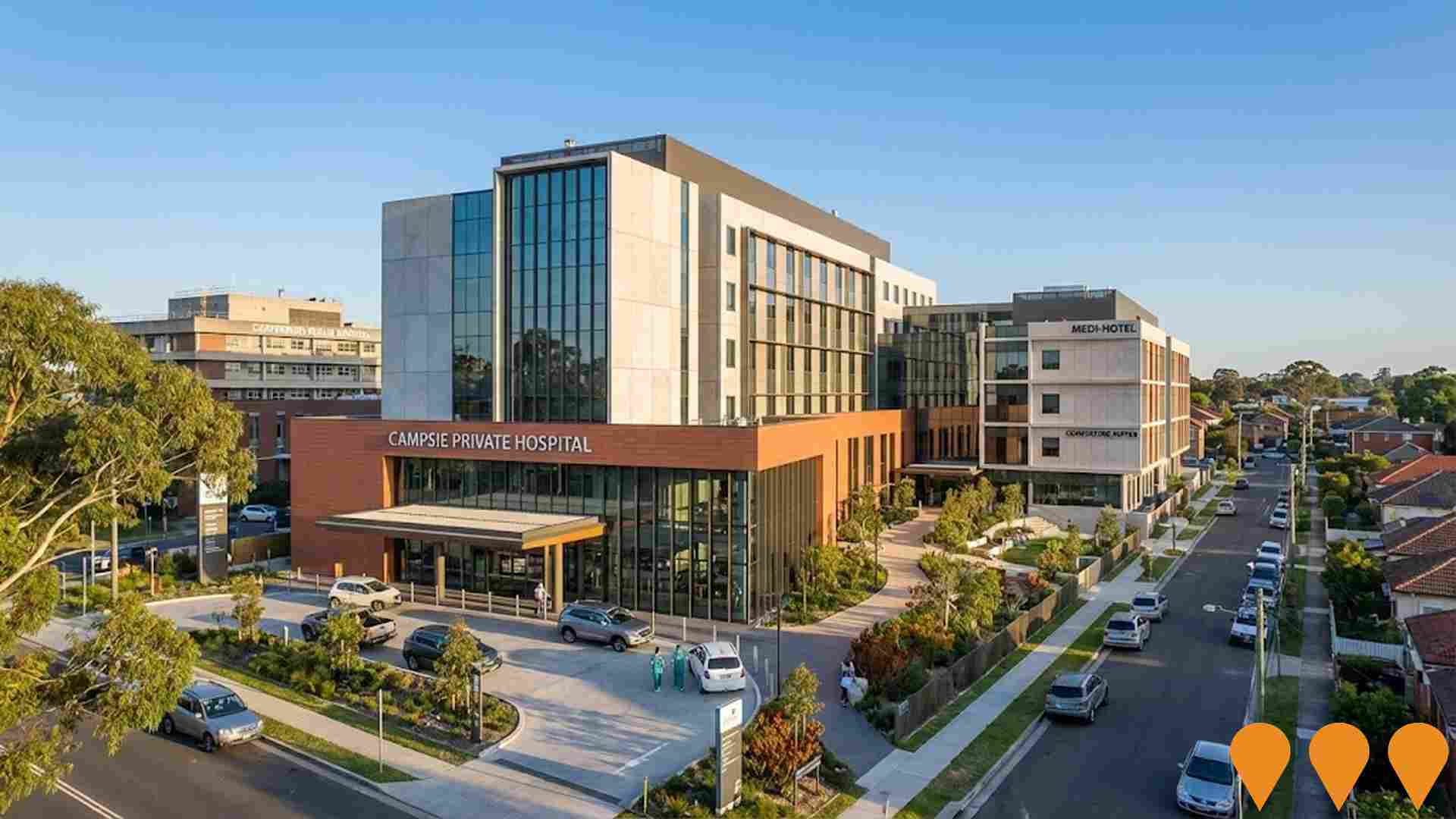
Canterbury Hospital Redevelopment
NSW Government is delivering a $470 million redevelopment of Canterbury Hospital (increased from original $350 million budget). The project is the largest expansion in over 25 years and includes a new clinical services building with expanded emergency department, intensive care unit, additional operating theatres, new inpatient units, expanded paediatric and maternity services, medical imaging, and a new main entry, and significant upgrades to existing facilities. Early works commenced in 2024, with main works construction starting in early 2025.
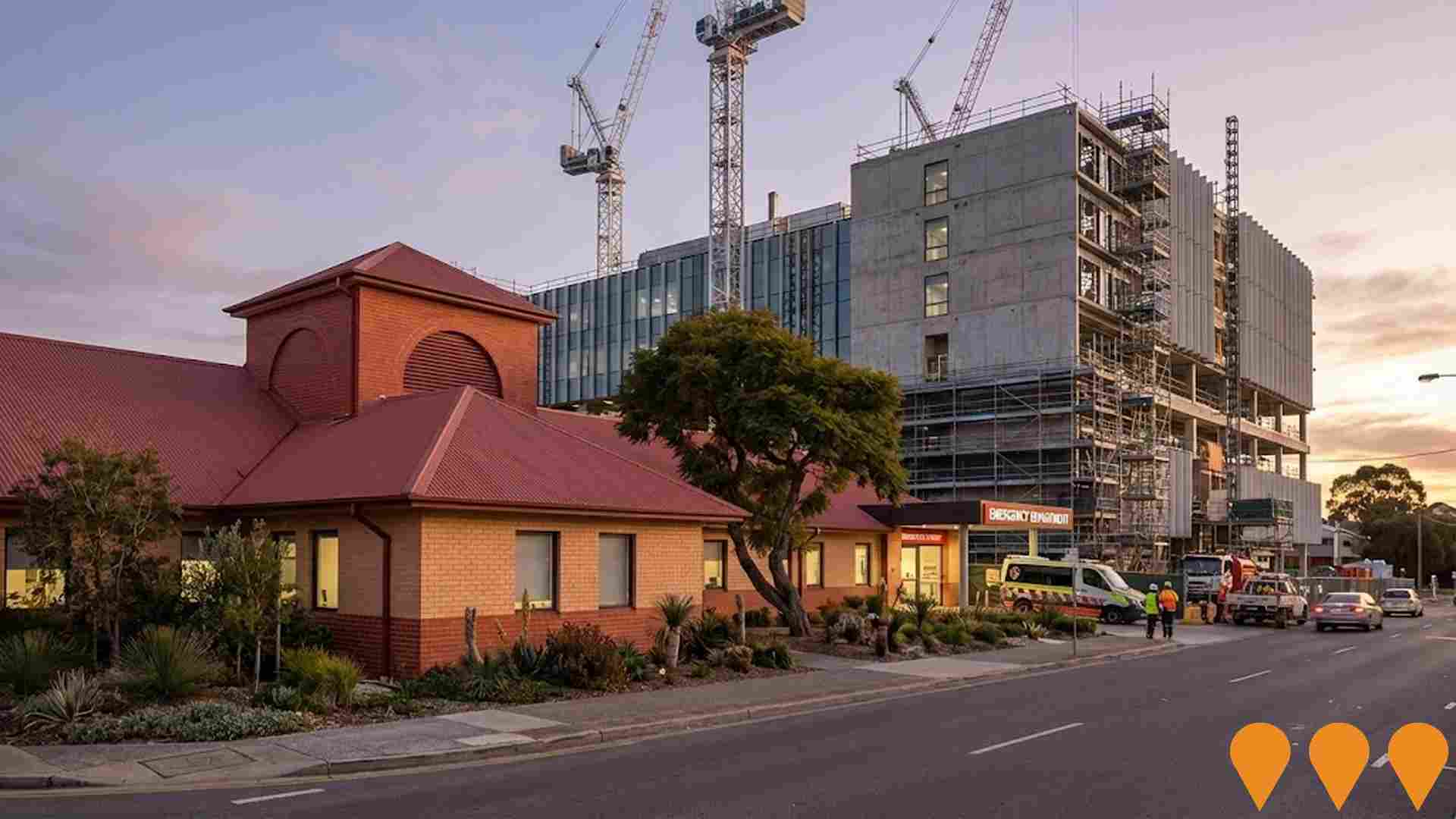
Campsie Private Hospital
A $150 million, 218-bed private hospital development (11 storeys) delivering inpatient and outpatient services, emergency department, intensive care, maternity, day surgery, cardiac catheterisation labs, dialysis and oncology services. The project will create approximately 400 construction jobs and over 1,100 ongoing operational jobs, significantly increasing acute healthcare capacity in the Canterbury-Bankstown region.

Campsie Private Hospital
A $451 million greenfield private hospital development delivering approximately 200 inpatient beds, 100-room Medi-Hotel, integrated specialist suites, 150-place childcare centre and associated medical services. The project will complement the existing Canterbury Hospital and create a major health precinct in Sydney's inner south-west.

Campsie Station Metro Upgrade
Major upgrade of Campsie Station as part of the Sydney Metro City & Southwest project. New metro platforms below the existing suburban station, full accessibility upgrades, platform screen doors, concourse expansion and integration with the future Campsie precinct redevelopment. Construction well advanced; testing and commissioning underway with passenger services now expected in 2026.

Sydney Metro City & Southwest - Sydenham to Bankstown (T3 Bankstown Line Conversion)
Conversion of the existing 13.5km T3 Bankstown Line between Sydenham and Bankstown to fully automated metro standards as the final stage of Sydney Metro City & Southwest. Includes upgrading 10 stations (Marrickville to Bankstown) plus Sydenham interchange with platform screen doors (plus mechanical gap fillers on curved platforms), full accessibility upgrades, line segregation, and enabling turn-up-and-go services every 4 minutes in peak. The line closed on 30 September 2024 for conversion works and intensive testing (high-speed testing commenced November 2025); opening now scheduled for 2026 due to earlier industrial impacts and integration complexity.

10 London Street & 43 North Parade Mixed Use Development
Large corner mixed-use development site with holding income from existing retail tenancies. Under the approved Campsie Town Centre Masterplan, the site has potential for up to 20-storey development with estimated GFA up to 12,633 sqm. Located directly opposite Campsie Railway Station with future Sydney Metro connectivity. The site comprises 1,632 sqm with B2 Local Centre zoning supporting residential, retail or hotel redevelopment.
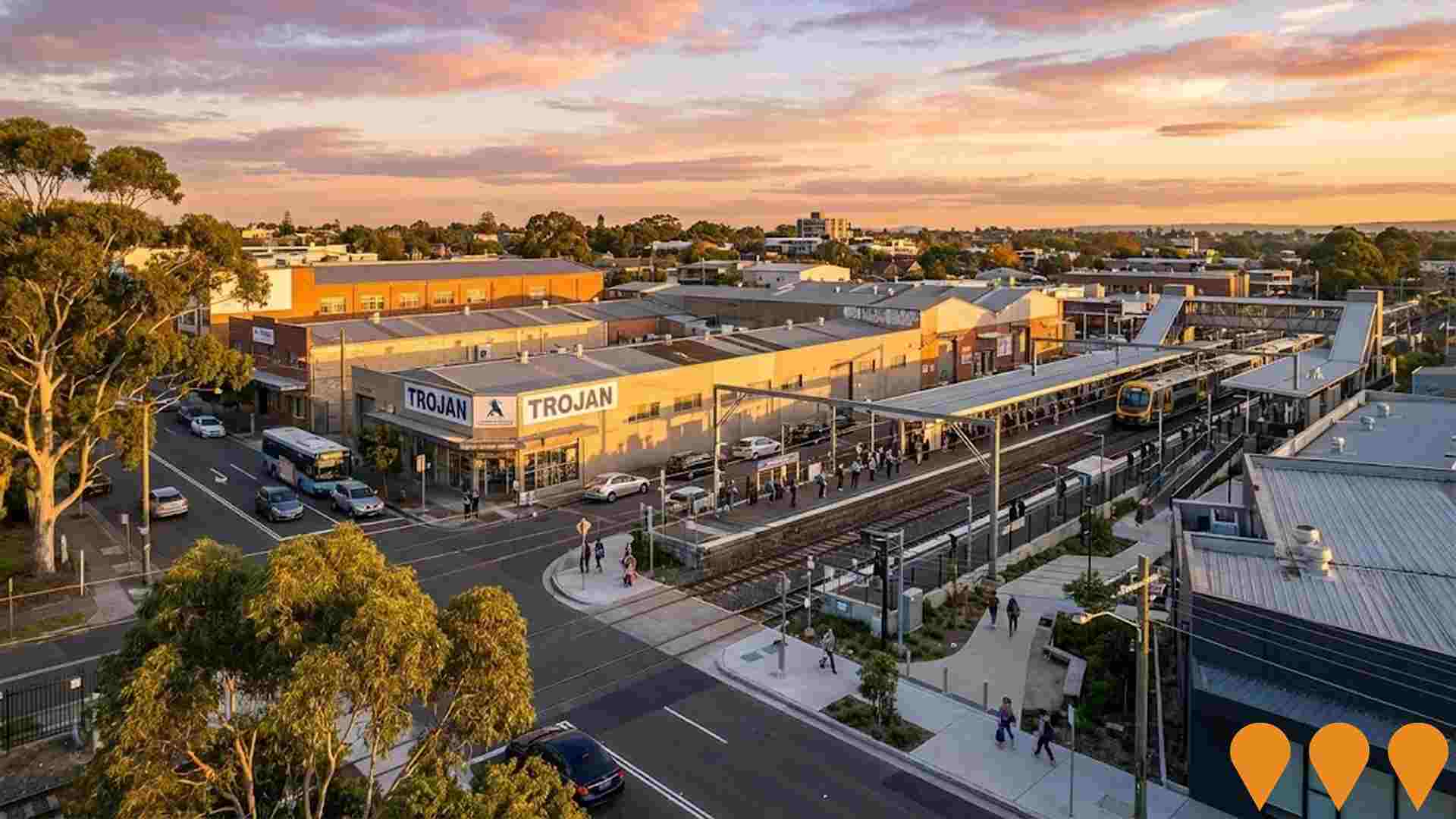
Employment
Employment performance in Canterbury - South has been broadly consistent with national averages
Canterbury - South has a highly educated workforce with professional services being well-represented. The unemployment rate was 3.4% in the past year, with an estimated employment growth of 2.4%.
As of June 2025, 7,809 residents were employed, with an unemployment rate of 0.7% lower than Greater Sydney's rate of 4.2%. Workforce participation was at 55.4%, compared to Greater Sydney's 60.0%. Employment is concentrated in health care & social assistance, retail trade, and professional & technical services. The area has a notable concentration in transport, postal & warehousing employment, which is 1.3 times the regional average.
However, professional & technical employment is limited at 9.1%, compared to the regional average of 11.5%. The predominantly residential area offers limited local employment opportunities, as indicated by the count of Census working population versus resident population. In the 12-month period ending June 2025, employment increased by 2.4% and the labour force grew by 2.6%, causing the unemployment rate to rise by 0.3 percentage points. This contrasts with Greater Sydney, where employment rose by 2.6%, the labour force grew by 2.9%, and unemployment rose by 0.3 percentage points. Jobs and Skills Australia's national employment forecasts from May 2025 project a 6.6% increase in employment over five years and a 13.7% increase over ten years. Applying these projections to Canterbury - South's employment mix suggests local growth of approximately 6.8% over five years and 13.9% over ten years, based on simple weighting extrapolation for illustrative purposes only.
Frequently Asked Questions - Employment
Income
The area's income profile falls below national averages based on AreaSearch analysis
Canterbury-South's median income among taxpayers was $48,617 in financial year 2022. The average income stood at $62,877 during the same period. These figures compare to Greater Sydney's median and average incomes of $56,994 and $80,856 respectively. Based on Wage Price Index growth of 12.61% since financial year 2022, estimated median income for Canterbury-South is approximately $54,748 as of September 2025, with the average estimated at around $70,806 during the same period. Census data shows household, family and personal incomes in Canterbury-South are at the 52nd percentile nationally. The largest income bracket comprises 36.2% earning between $1,500 to $2,999 weekly, with 4,771 residents falling into this category. This is consistent with broader trends across the area showing 30.9% in the same income bracket. Housing affordability pressures are severe, with only 79.9% of income remaining after housing costs, ranking at the 49th percentile nationally. The area's SEIFA income ranking places it in the 6th decile.
Frequently Asked Questions - Income
Housing
Canterbury - South features a more urban dwelling mix with significant apartment living, with a higher proportion of rental properties than the broader region
Canterbury-South's dwelling structure, as per the latest Census, consisted of 39.4% houses and 60.6% other dwellings (semi-detached, apartments, 'other' dwellings). In contrast, Sydney metro had 48.7% houses and 51.3% other dwellings. Home ownership in Canterbury-South stood at 24.0%, with mortgaged dwellings at 32.0% and rented ones at 44.0%. The median monthly mortgage repayment was $2,221, higher than Sydney metro's $2,167. The median weekly rent was $450, compared to Sydney metro's $390. Nationally, Canterbury-South's mortgage repayments were significantly higher at $2,221 versus the Australian average of $1,863, and rents were substantially above the national figure of $375.
Frequently Asked Questions - Housing
Household Composition
Canterbury - South features high concentrations of group households, with a lower-than-average median household size
Family households constitute 69.7% of all households, including 32.0% couples with children, 24.4% couples without children, and 11.7% single parent families. Non-family households comprise the remaining 30.3%, with lone person households at 25.2% and group households at 5.1%. The median household size is 2.5 people, smaller than Greater Sydney's average of 2.9.
Frequently Asked Questions - Households
Local Schools & Education
The educational profile of Canterbury - South exceeds national averages, with above-average qualification levels and academic performance metrics
The area's educational profile is notable regionally with university qualification rates at 36.6% of residents aged 15+, exceeding the Australian average of 30.4% and that of SA3 area at 31.0%. Bachelor degrees are most prevalent at 25.0%, followed by postgraduate qualifications at 9.6% and graduate diplomas at 2.0%. Vocational credentials are also prominent, with 26.6% of residents aged 15+ holding such qualifications - advanced diplomas at 11.6% and certificates at 15.0%.
Educational participation is high, with 30.7% of residents currently enrolled in formal education, including 7.7% in primary, 7.2% in tertiary, and 6.5% pursuing secondary education. Canterbury South Public School provides local educational services within Canterbury - South, with an enrollment of 258 students as of the latest available data. The area demonstrates typical Australian school conditions (ICSEA: 1033) with balanced educational opportunities. There is one school focusing exclusively on primary education, with secondary options available in surrounding areas. Local school capacity is limited at 2.0 places per 100 residents compared to the regional average of 9.6, indicating many families travel to nearby areas for schooling.
Frequently Asked Questions - Education
Schools Detail
Nearby Services & Amenities
Transport
Transport servicing is high compared to other areas nationally based on assessment of service frequency, route connectivity and accessibility
Canterbury-South has 33 active public transport stops, all of which are bus stops. These stops are served by 46 different routes that together facilitate 3,899 weekly passenger trips. Residents enjoy excellent transport accessibility, with an average distance of 142 meters to the nearest stop.
The service frequency is 557 trips per day across all routes, translating to about 118 weekly trips per individual stop.
Frequently Asked Questions - Transport
Transport Stops Detail
Health
Canterbury - South's residents boast exceedingly positive health performance metrics with younger cohorts in particular seeing very low prevalence of common health conditions
Health outcomes data shows excellent results across Canterbury-South, with younger age groups having a very low prevalence of common health conditions.
Private health cover stands at approximately 51% of the total population (~6,736 people), slightly lower than the average SA2 area. The most prevalent medical conditions are mental health issues and asthma, affecting 5.5% and 5.1% of residents respectively. A total of 78.1% of residents report no medical ailments, compared to 77.7% across Greater Sydney. As of June 20XX (exact year not specified), 14.1% of residents are aged 65 and over (1,852 people), which is lower than the 15.8% in Greater Sydney. Although health outcomes among seniors are strong, they require more attention than the broader population.
Frequently Asked Questions - Health
Cultural Diversity
Canterbury - South is among the most culturally diverse areas in the country based on AreaSearch assessment of a range of language and cultural background related metrics
Canterbury-South has a population where 52.7% were born overseas, with 63.8% speaking languages other than English at home. Christianity is the predominant religion in Canterbury-South, accounting for 50.2%. Buddhism is notably higher here compared to Greater Sydney, making up 7.5% of the population.
The top three ancestry groups are Other (21.6%), Chinese (17.7%, significantly higher than the regional average of 12.4%), and English (9.6%). Some ethnic groups have notable divergences: Greek is overrepresented at 9.6%, Lebanese at 5.5% (both lower than regional averages), and Vietnamese at 3.9%.
Frequently Asked Questions - Diversity
Age
Canterbury - South's population is younger than the national pattern
Canterbury - South's median age is 35 years, which is slightly younger than Greater Sydney's 37 years and also somewhat younger than Australia's national average of 38 years. The 25-34 age group has a strong representation in Canterbury-South at 19.1%, compared to Greater Sydney. However, the 5-14 age cohort is less prevalent at 9.9%. Between 2021 and present, the 15-24 age group has grown from 10.9% to 12.0% of the population, while the 25-34 age group has declined from 21.2% to 19.1%. By 2041, population forecasts indicate substantial demographic changes for Canterbury-South. The 45-54 age cohort is projected to increase significantly, expanding by 504 people (32%) from 1,571 to 2,076. Conversely, population declines are projected for the 0-4 and 25-34 age cohorts.


